After the indulgences of Japanese New Year celebrations, we enjoy Nanakusa Gayu (七草粥) or seven herb rice porridge on January 7th. This mild and comforting okayu allows our stomachs to recover from the feasts we enjoyed during the holiday in Japan.
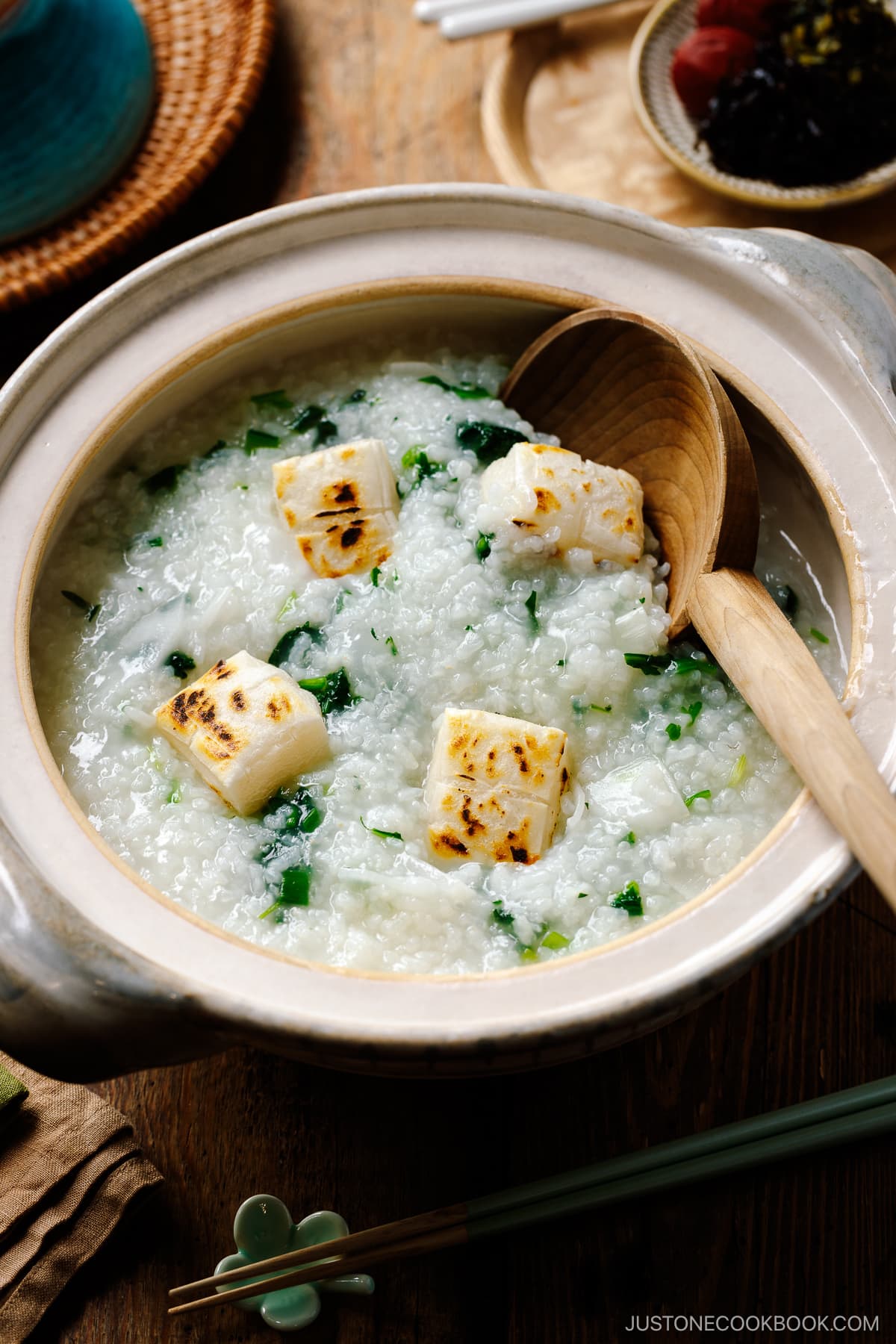
On January 7th each year, the Japanese observe a tradition known as Nanakusa no Sekku (七草の節句), or the Festival of the Seven Herbs, by eating a healthy rice porridge called nanakusa gayu (七草粥). This time-honored custom is believed to bring good health and ward off evil spirits for the rest of the year.
The simple meal of rice porridge hits the spot after all the New Year feasting and helps our overindulged stomachs to heal and recover. If you’re ready for a reset, this tasty yet light porridge is a delicious way to get back on track.
Table of Contents
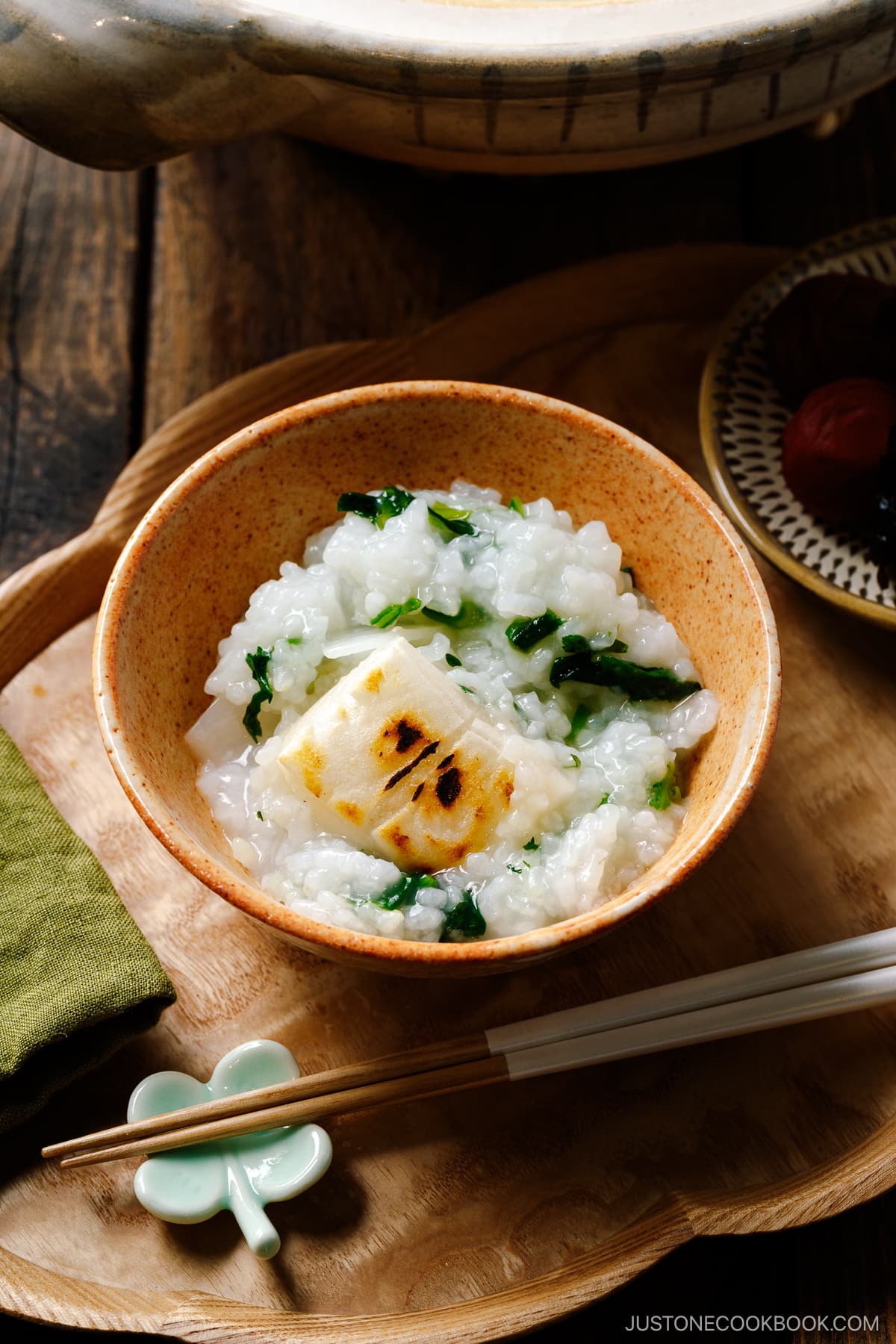
What is Nanakusa Gayu?
Nanakusa gayu (seven herb rice porridge) is a type of okayu, or rice porridge, made with seven herbs (七 nana 草 kusa). We sometimes call it haru no nanakusa (春の七草), which means “spring‘s seven herbs,” because the young herbs that are available during this time of year are more tender and fragrant.
The custom of eating hot rice porridge on the 7th day of the Japanese New Year has its roots in Chinese belief and traces back to ancient times in Japan. Based on the Chinese legend, January 7th is also known as Jinjitsu (人日), one of the 5 seasonal festivals (節句), during which we celebrate everyone’s birthday as it is considered the day humans were born.
In Japan, we usually eat a plain bowl of okayu when we’re feeling under the weather because it is light, comforting, and easy on the stomach. It heals any heavy feelings or sicknesses. As we wrap up the New Year festivities, it makes sense to eat nanakusa gayu. Since there is little green during the winter, the porridge’s young herbs bring color to the table and represent renewal for the new year.
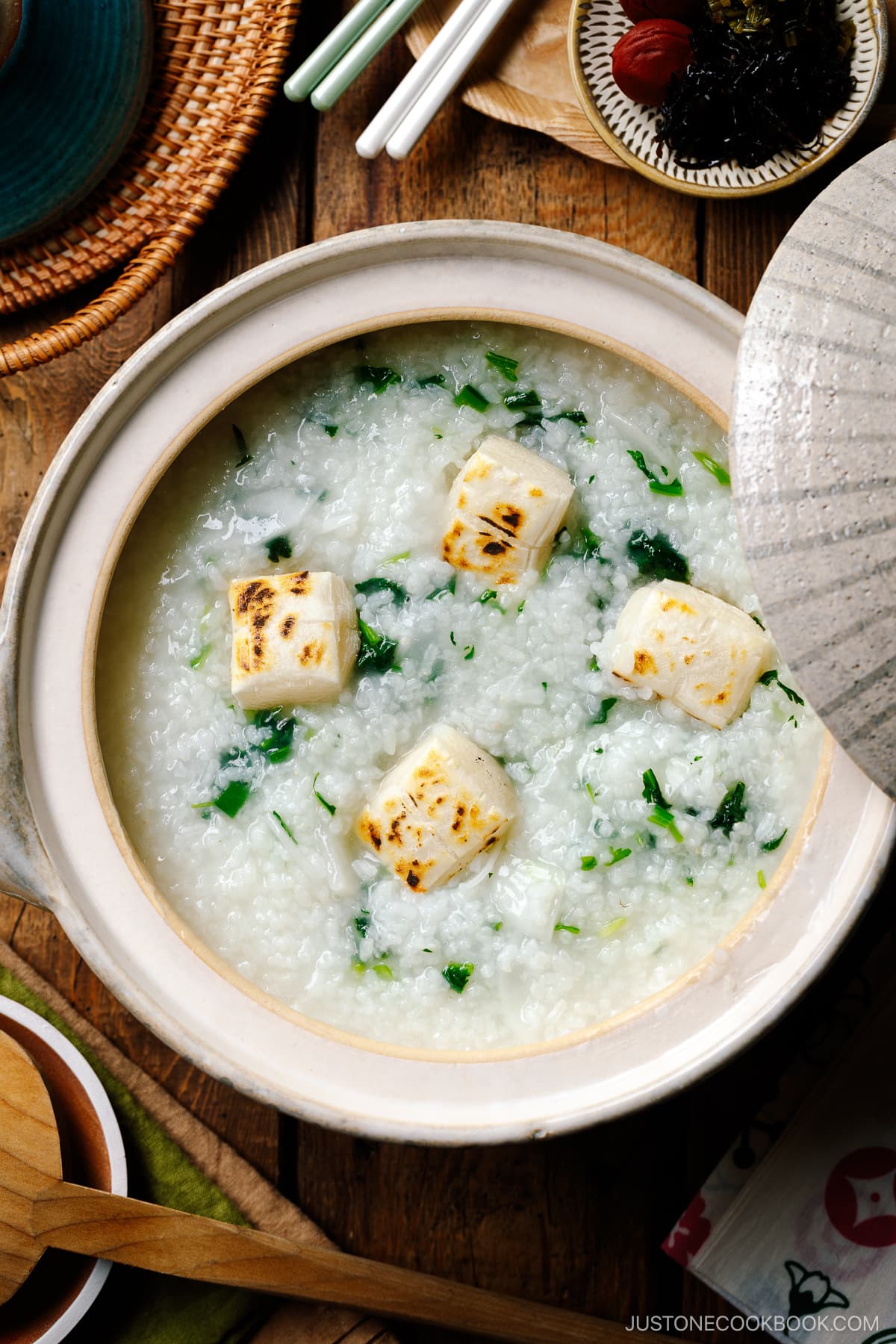
What Are the Nanakusa (Seven Herbs)?
Here are the seven herbs used in nanakusa gayu:
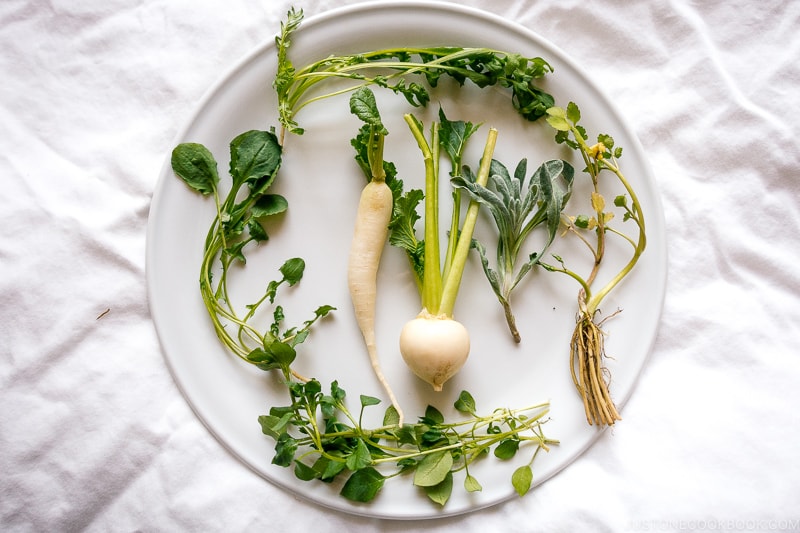
- Water dropwort – Seri (せり)
- Shepherd’s purse – Nazuna (なずな・ぺんぺん草)
- Cudweed – Gogyo (ごぎょう)
- Chickweed – Hakobera (はこべら)
- Nipplewort – Hotokenoza (ほとけのざ)
- Turnip – Suzuna (すずな・かぶ)
- Daikon radish – Suzushiro (すずしろ・大根)
🎶 To help remember the herbs, we even have a song that goes like this: “Seri Nazuna, Gogyo Hakobera Hotokenoza, Suzuna Suzushiro Korezo Nanakusa.”「せり なずな、 ごぎょう はこべら ほとけのざ、 すずな すずしろ、これぞななくさ」
Where To Find Nanakusa
In Japan
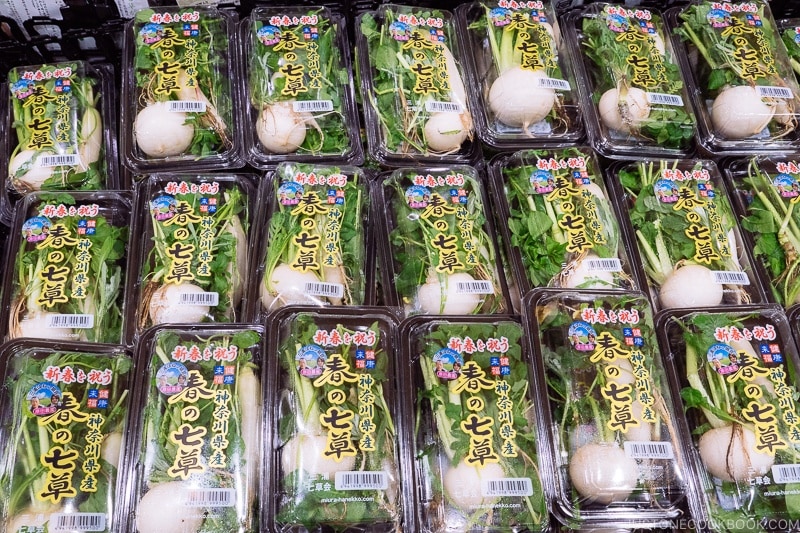
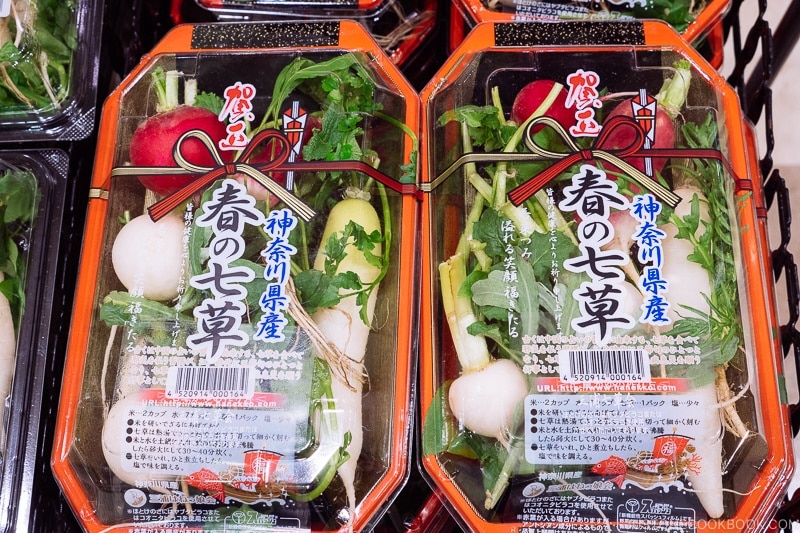
You can find convenient “Haru no Nanakusa Set” (春の七草セット) packages in grocery stores in Japan. They are a bundle of fresh herbs ready to use in making nanakusa gayu.
Outside of Japan
It’s challenging to find all seven traditional herbs outside of Japan. However, you can still make nanakusa gayu and enjoy the porridge at home.
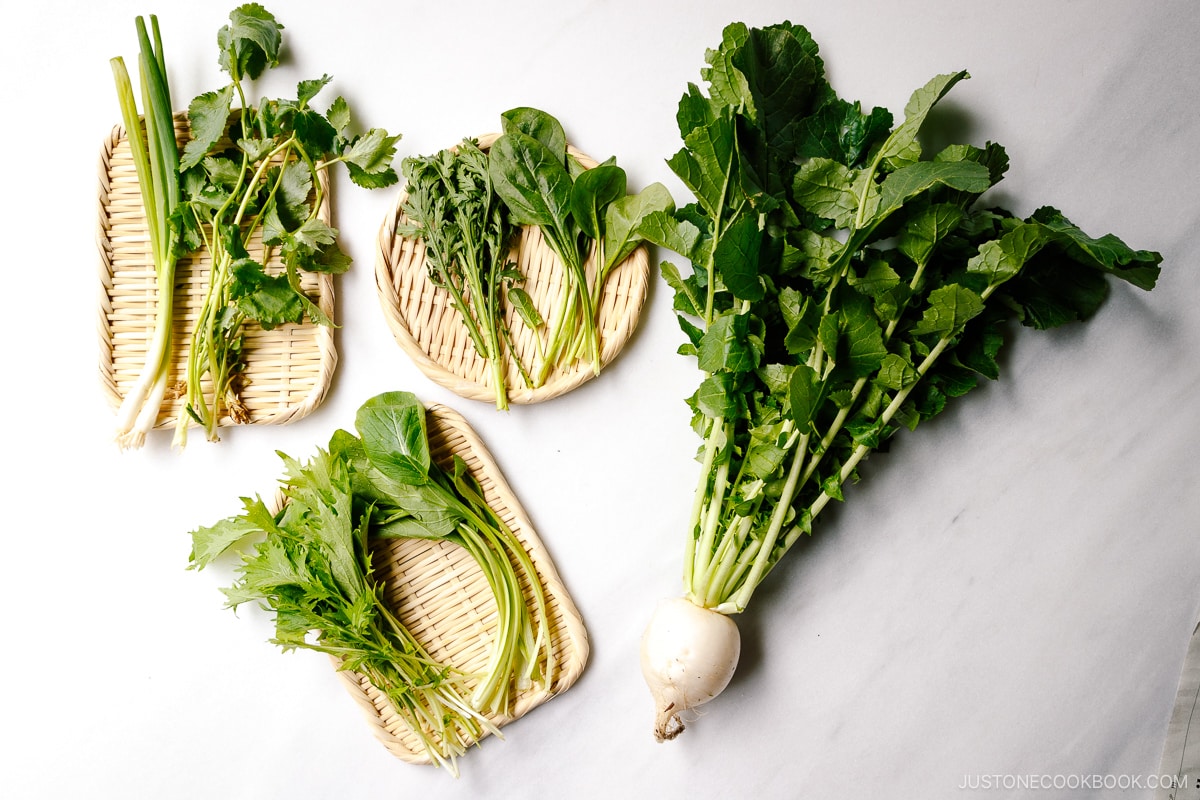
Locally available herbs/greens: Over the years, I’ve cooked with various herbs and made my own versions, and each one turns out just as delicious. Here are some greens I’ve used from a Japanese market:
- Daikon leaves and daikon radish – Got this fresh one from my neighbor’s garden!
- Spinach
- Chrysanthemum greens (shungiku)
- Komatsuna greens
- Mizuna
- Mitsuba
- Green onions/scallions
You can also use basil, chervil, chives, fennel, mint, and watercress. Use a selection of greens you enjoy that are available near you. Make sure nothing is too strong or dominant in the amount that overpowers the flavors.
Freeze-dried nanakusa: You can also buy a freeze-dried nanakusa package from Japan at a Japanese grocery store in your area.
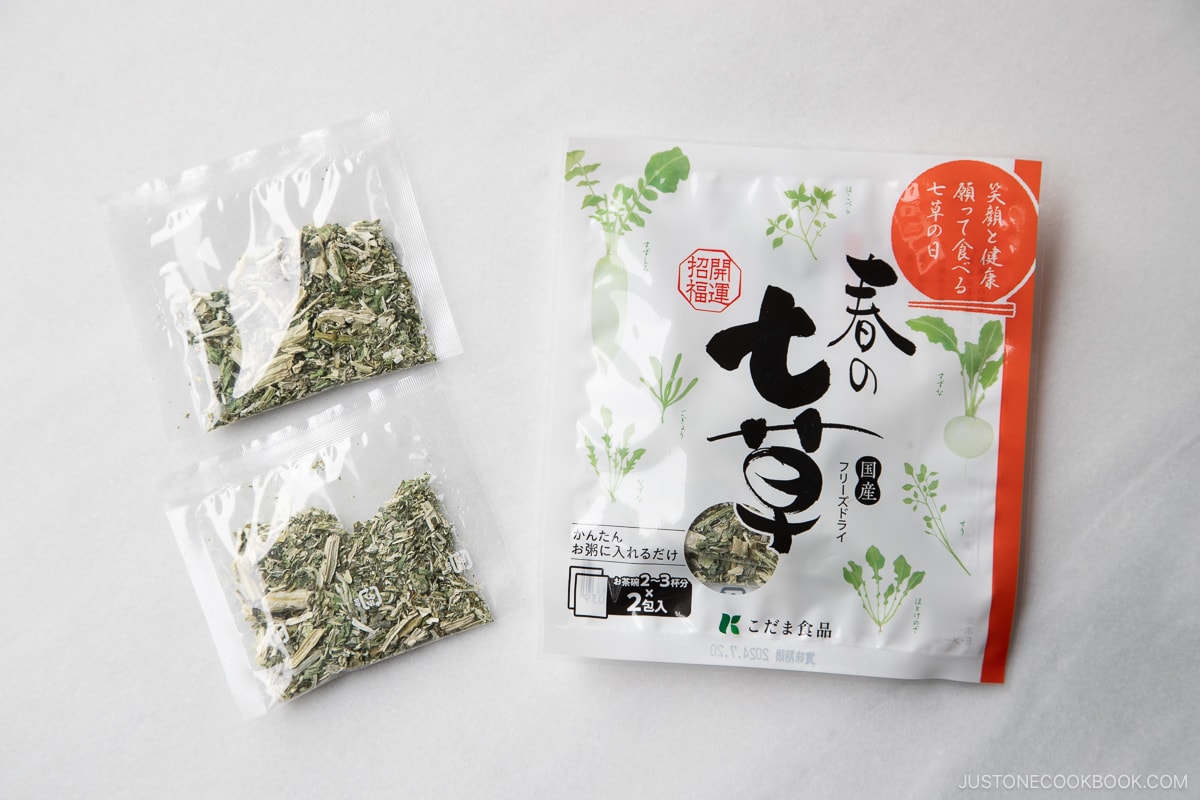
How to Make Nanakusa Gayu
It’s very simple and easy to make Japanese rice porridge. Here’s a quick summary of how to make it. For precise ingredients and step-by-step instructions, see the recipe card below.
Jump to Recipe- Wash the rice and drain well. Put the rice and measured water in a heavy-bottomed pot.
- Bring it to a boil over medium heat. Stir the rice once it boils, then reduce the heat to low. Cover with the lid slightly ajar and cook for 30 minutes.
- While the rice is cooking, prepare the daikon and the herbs/greens. Cut the daikon into thin slices and cut the herbs/greens into halves or thirds. Cook the daikon until tender and blanch the herbs/greens for 20 seconds.
- Once the porridge is done, season to taste with salt.
- Add the cooked daikon and herbs/greens.
- Cover and let it steam for 5 minutes.
- Optionally, you can add toasted mochi pieces on top. Enjoy!
Rice-to-Water Ratio for Rice Porridge
I use 1 rice cooker cup (180 ml) of uncooked Japanese short-grain rice and 1 L (1000 ml) of water to make nanakusa gayu. I like this ratio because it’s easy to remember. It also has the typical zengayu (全粥) consistency, with barely any liquid left in the pot after cooking.
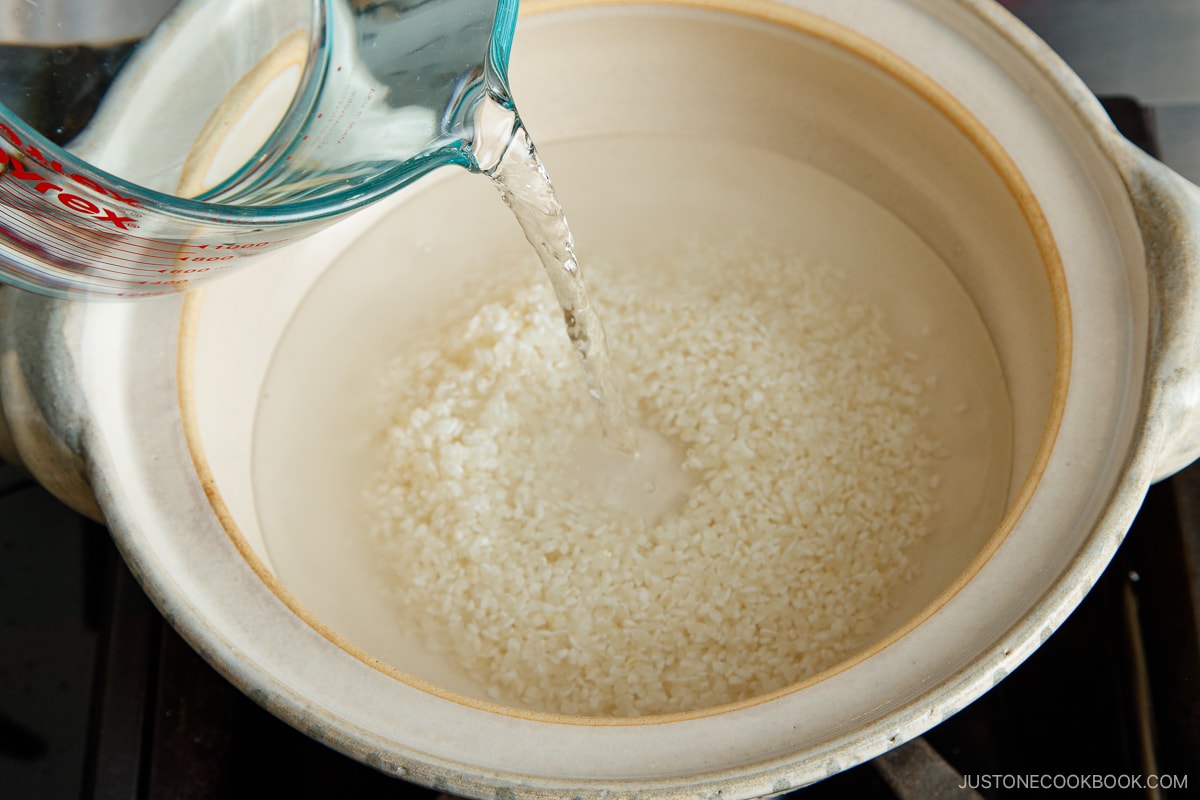
If you like a more watery consistency, you can increase the water amount to 1.2 L (1200 ml).
Rice-to-Water Ratios for your Desired Consistency (1 rice cooker cup is 180 ml):
- 1:5 – Zengayu (全粥, 五倍粥) = 1 rice cooker cup + 900 ml (not much water left)
- 1:7 – Shichibugayu (七分粥, 七倍粥) = 1 rice cooker cup + 1260 ml
- 1:10 – Gobugayu (五分粥, 十倍粥) = 1 rice cooker cup + 1800 ml
- 1:20 – Sanbugayu (三分粥, 二十粥) = 1 rice cooker cup + 3600 ml (very watery)
Make Porridge Using Cooked Rice
You can make Nanakusa Gayu with cooked rice. Use leftover rice or defrost frozen rice. (Freezing is the best way to store cooked rice!) The ratio of cooked rice to water (by volume) is 1:2 or 1:3.
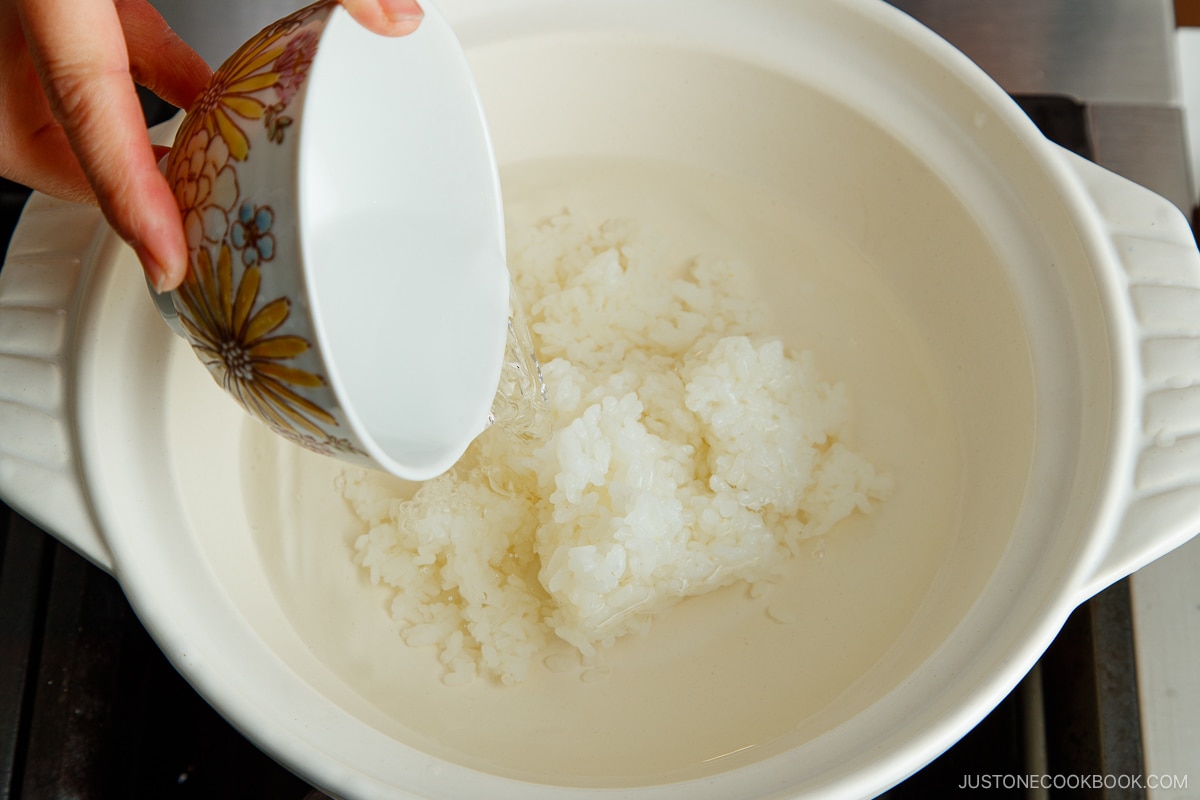
The easiest way to measure is with a Japanese rice bowl. For 2 servings of rice porridge, use 1 rice bowl (200 ml size) of cooked rice and 2-3 rice bowls of water. For zengayu consistency, use 2 rice bowls of water.
Cooking Tips
If you’re new to making rice porridge, here are a few things to keep in mind:
- Use a heavy-bottomed pot like a donabe (Japanese clay pot) or Dutch oven. The rice cooks more evenly because thicker pots distribute heat beautifully compared to regular, thinner pots that tend to have hot spots.
- When cooking the rice, cover the pot with the lid slightly ajar, especially if the pot is shallow or does not have much space. This prevents pressure and steam from the starchy water from building up and boiling over. Do not open the lid or stir while cooking.
- Turn the heat to medium to bring it to a boil, then reduce to low and cook for 30 minutes. Turn off the heat and let it steam for 5 minutes.
- Blanch the herbs/greens in salted water separately, then add them to the porridge at the end to help maintain their bright color.
- Optionally, add toasted rice cakes on top. While my mom did not add kirimochi to her Nanakusa Gayu, I learned that some people do, and my family loves it! It’s a great way to use up leftover kirimochi from Japanese New Year.
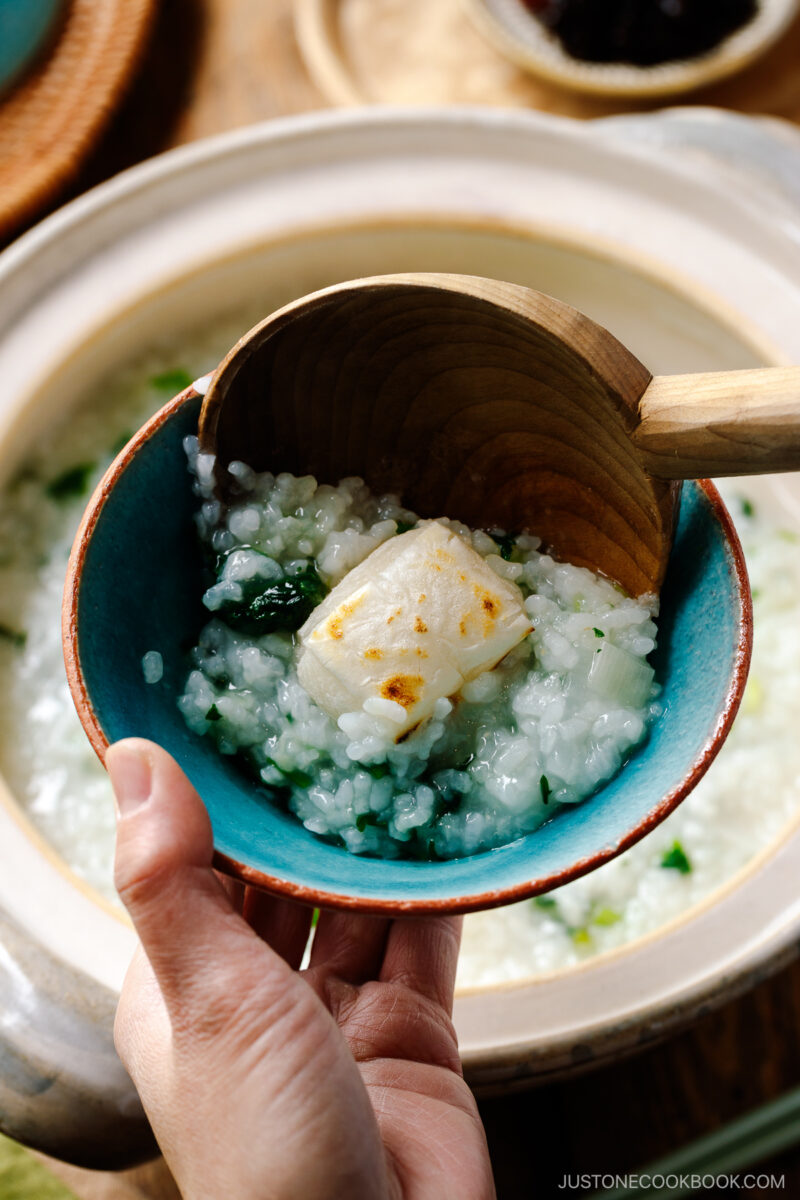
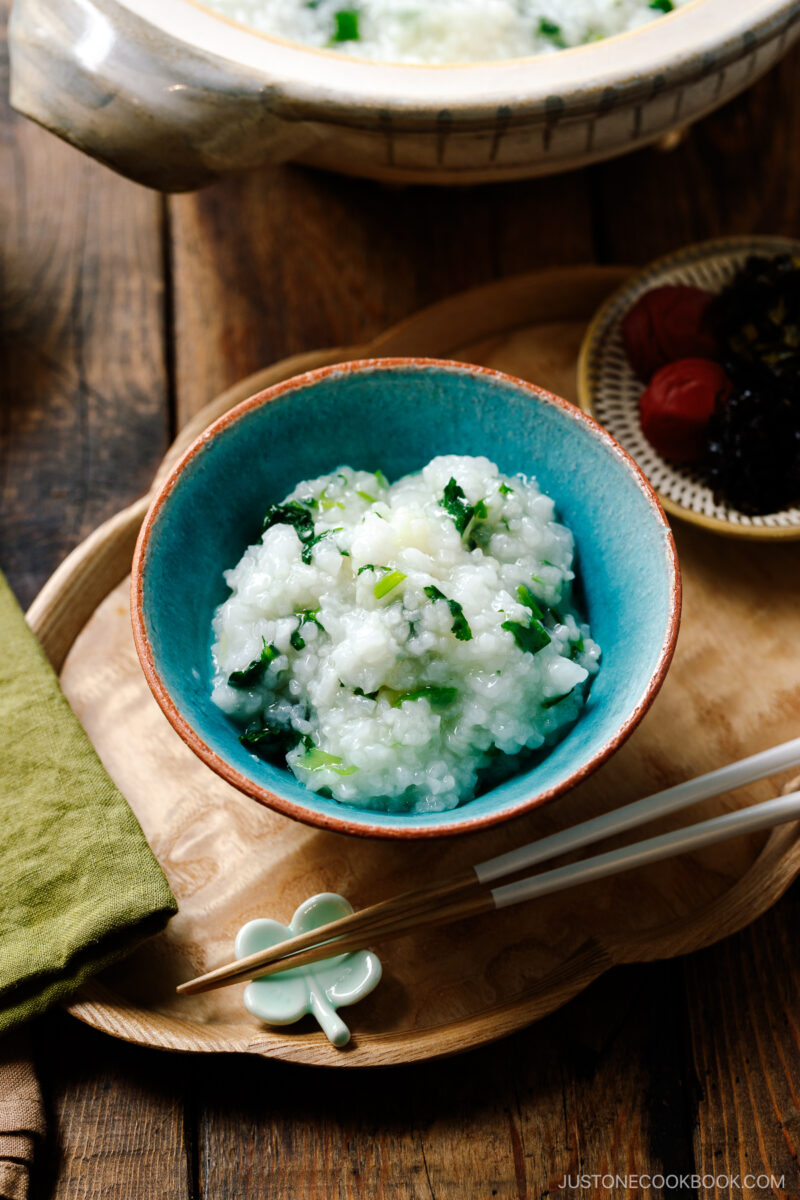
Use Donabe (Japanese Clay Pot) for Nanakusa Gayu
For the best-tasting okayu, I recommend using a donabe (土鍋), a Japanese earthenware pot, to cook the porridge.
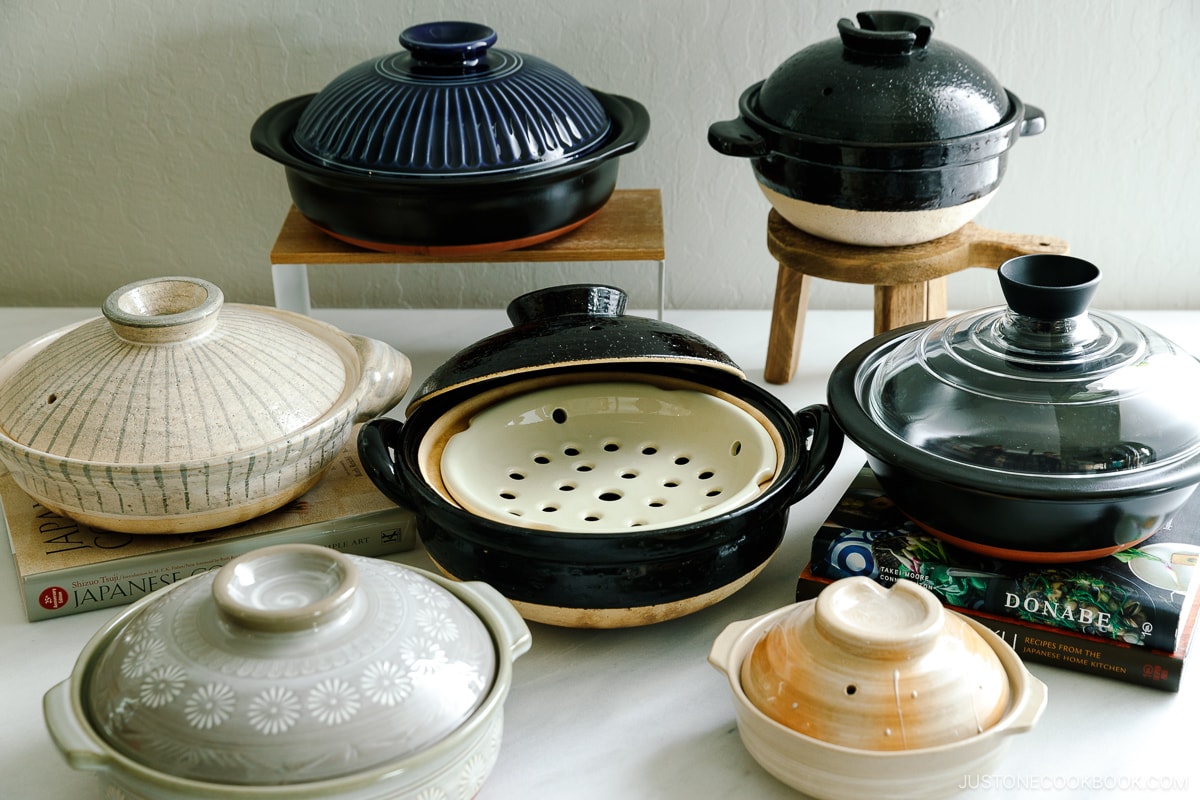
This traditional clay pot distributes heat beautifully and retains heat well, and it makes lovely serveware for nanakusa gayu. It certainly suits the spirit of Japanese New Year to serve such a meaningful meal in a traditional donabe.
If you are shopping for a donabe, please see my tips on how to choose the best donabe for you. Before you use your donabe for the first time, please learn how to season and care for your donabe.
More on Japanese New Year Traditions and Foods
- How Do The Japanese Celebrate The Japanese New Year
- Toshikoshi Soba (Japanese New Year’s Eve Noodles)
- Osechi Ryori (Japanese New Year Food)
- Kagami Biraki – Mochi Breaking Ceremony
- Eating Nanakusa Gayu on The Festival of the Seven Herbs
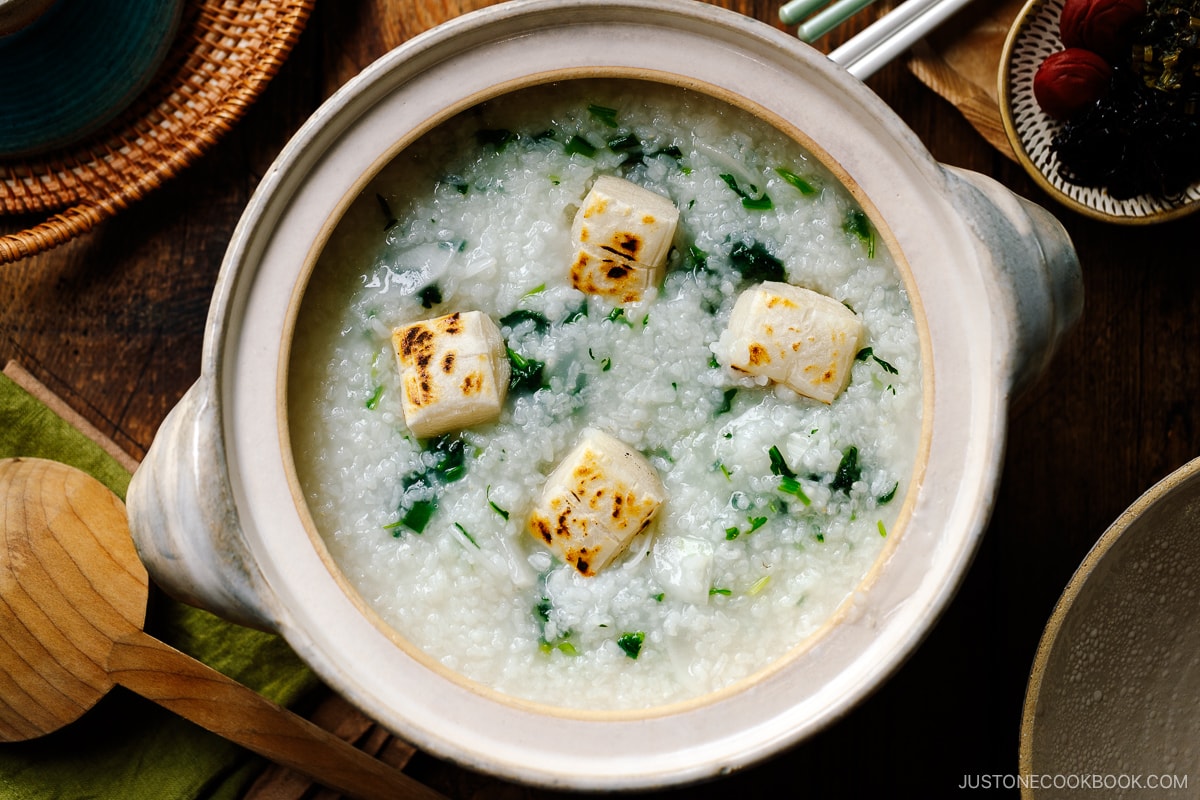
Wish to learn more about Japanese cooking? Sign up for our free newsletter to receive cooking tips & recipe updates! And stay in touch with me on Facebook, Pinterest, YouTube, and Instagram.
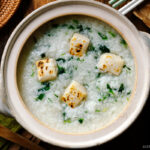
Nanakusa Gayu (Seven Herb Rice Porridge)
Ingredients
For the Rice Porridge (4 servings)
- ¾ cup uncooked Japanese short-grain white rice (1 rice cooker cup)
- 4¼ cups water (1 L)
- 1½ inches daikon radish
- 7 kinds of herbs/greens of your choice (a very small portion, about 1–2 stems/sprigs each; I used fresh daikon leaves, spinach, chrysanthemum greens (shungiku), komatsuna greens, mizuna, mitsuba, and green onions; or use 1 freeze-dried nanakusa set package from a Japanese grocery store; in Japan, get 1 fresh nanakusa set package)
- ½ tsp Diamond Crystal kosher salt (divided; plus more, to taste)
- 2 pieces Japanese rice cake (kiri mochi) (optional)
For Serving
- condiments of your choice (optional; typically salty condiments like tsukemono, simmered kombu, or umeboshi)
For the Porridge Using Cooked Rice (optional; 2 servings)
- 1 rice bowl cooked Japanese short-grain rice (1 cup, 150 g)
- 2–3 rice bowls water (2–3 cups, 400–600 ml; adjust to your preferred consistency)
Instructions
- Gather all the ingredients. You will need a very small portion of each herb/green (I did not use the whole leaves you see in this picture). You will also need a heavy-bottomed pot like a donabe or Dutch oven, which cooks the rice more evenly because the heat distribution is not as strong and direct as a regular pot.
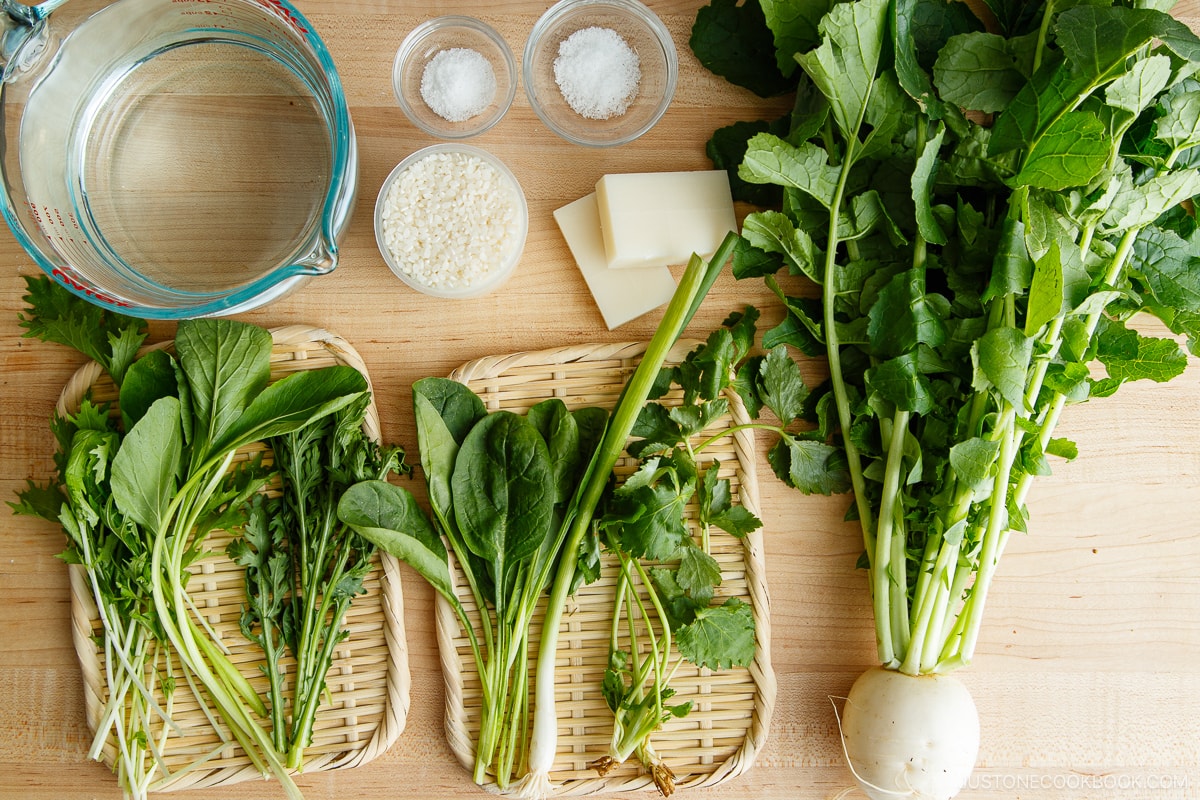
To Wash and Cook the Rice
- Wash ¾ cup uncooked Japanese short-grain white rice and drain well in a fine-mesh sieve. For detailed instructions on how to wash rice, see my How to Cook Rice recipe card. Transfer the well-drained rice to a donabe or heavy-bottomed pot.
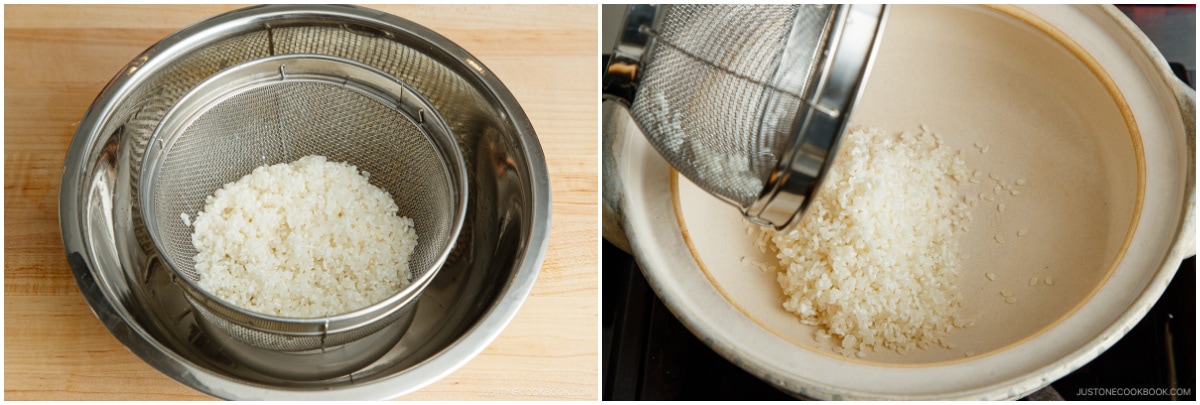
- Add 4¼ cups water to the donabe. Optionally, you can soak the rice for 30 minutes at this step. Then, turn the stove‘s heat to medium and stir occasionally while you bring it to a boil.
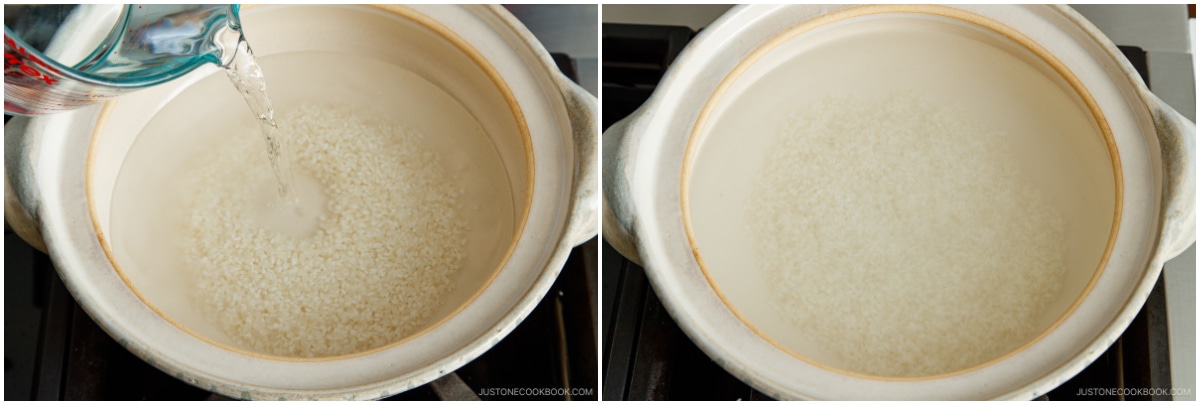
- As soon as it‘s boiling, reduce the heat to low and gently mix once with a spoon, making sure the rice is not stuck to the bottom of the pot. Cover the donabe with the lid slightly ajar (to avoid boiling over) and cook for 30 minutes. Do not open the lid or stir while cooking. Note: If you soaked the rice for 30 minutes, you can shorten the cooking time by 5–10 minutes.
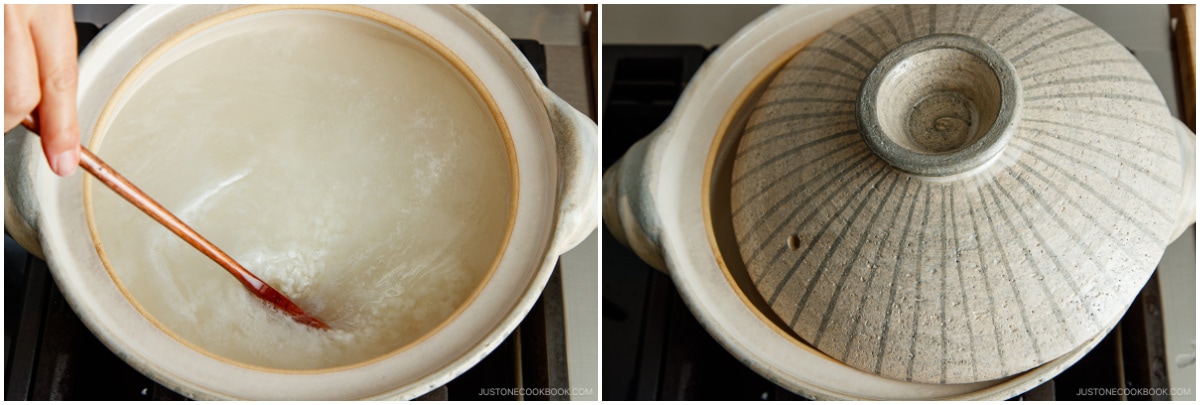
To Prepare the Daikon and Herbs/Greens
- While cooking the rice, let‘s prepare the daikon and greens. Bring a medium saucepan of water to a boil. Peel 1½ inches daikon radish and cut it into quarters lengthwise. Then, cut them crosswise into ⅛-inch (3-mm) quarter slices.
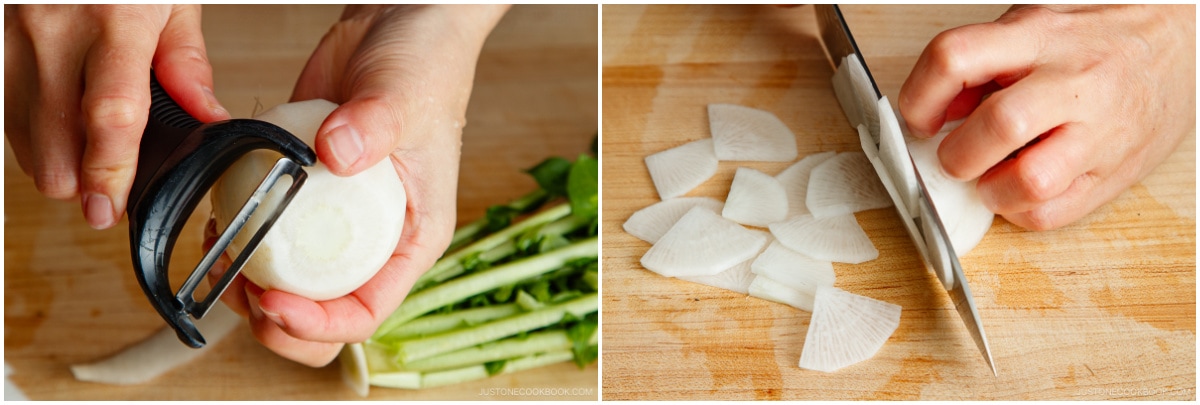
- When the water is boiling, add ¼ tsp Diamond Crystal kosher salt and the daikon.
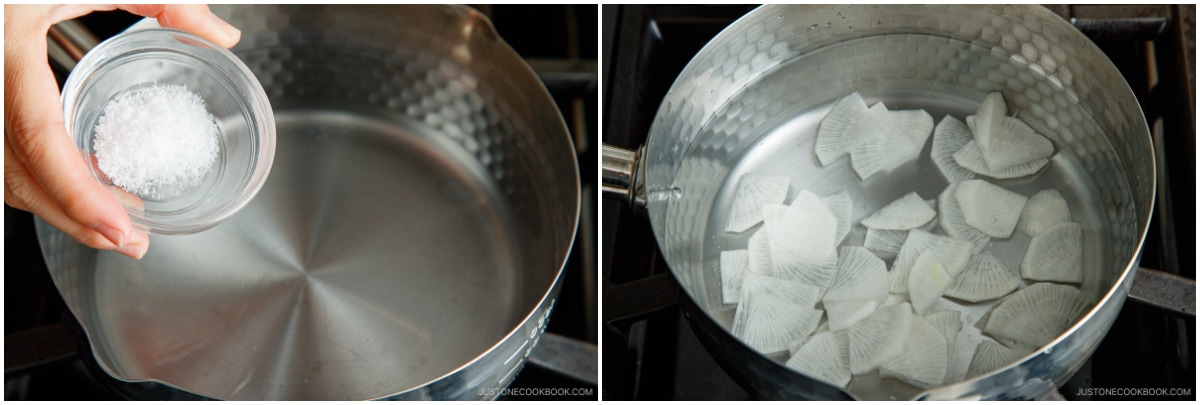
- Blanch until tender, about 4–5 minutes. To keep the boiling water for the next step, scoop out the daikon with a fine-mesh skimmer or slotted spoon and transfer it to a dish or tray.
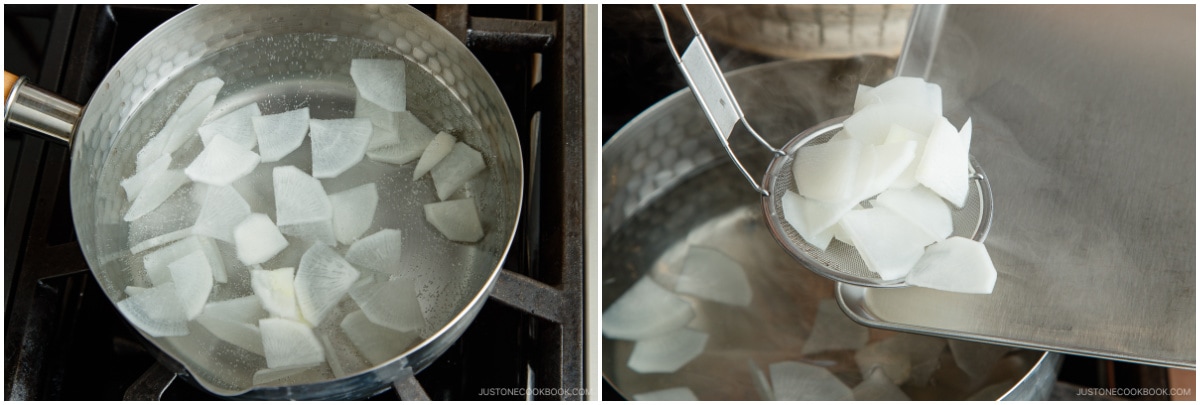
- Cut in half crosswise the 7 kinds of herbs/greens of your choice, including the tender stems. Blanch in the boiling water for 20–30 seconds. Tip: Salt water keeps the green color bright.
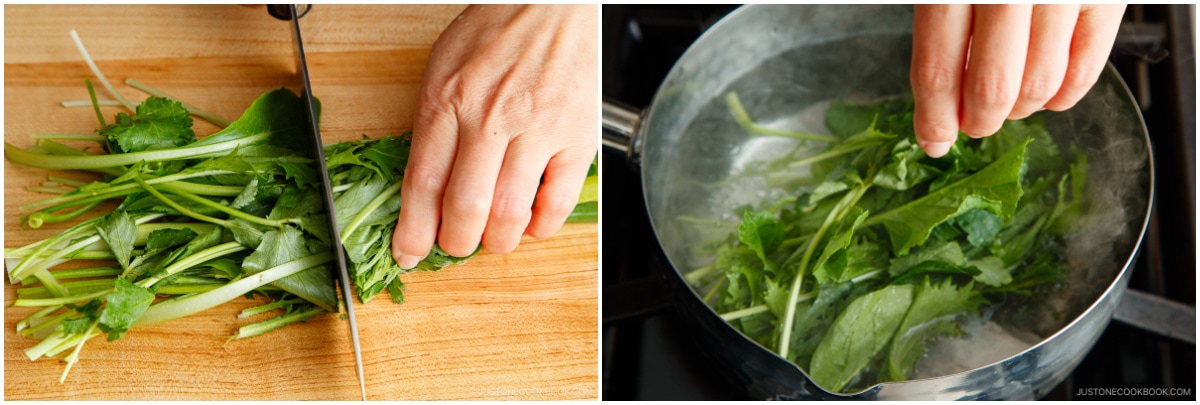
- Drain and immediately transfer the greens to iced water. This also helps keep the greens‘ bright color and stops cooking further.
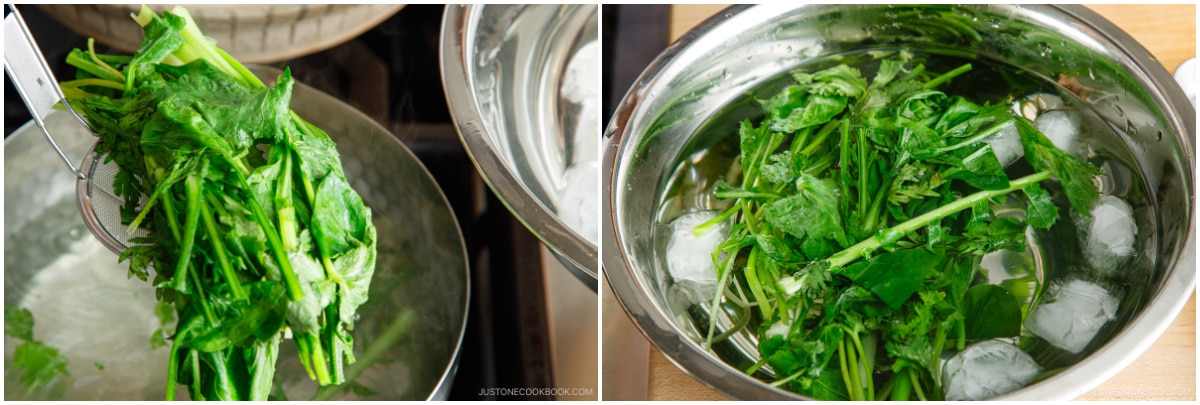
- Once cooled, squeeze out the water. Cut into ½-inch (1.3-cm) pieces. Aim for about 4 Tbsp of cooked and chopped herbs/greens. Tip: Don‘t let the greens soak in water too long, otherwise they will lose nutrients.
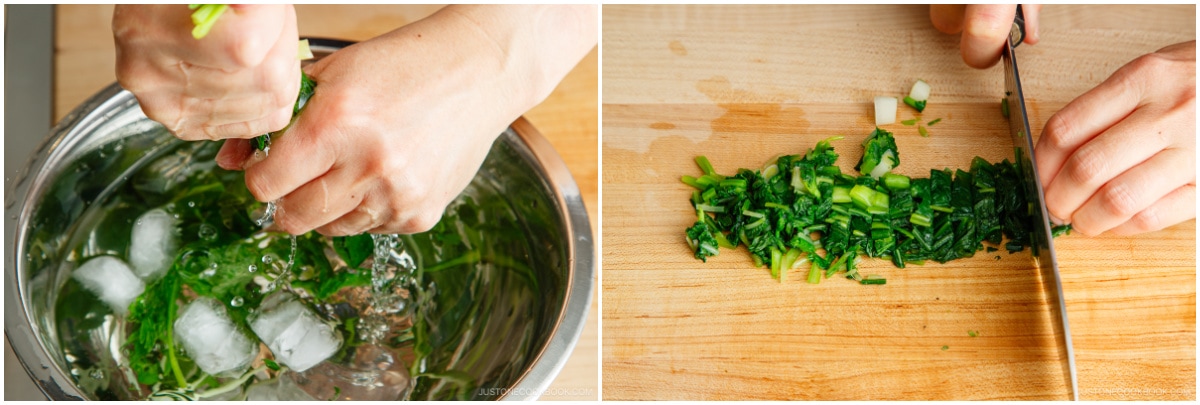
To Steam the Nanakusa Gayu
- After cooking the rice for 30 minutes (or 20–25 minutes if you pre-soaked the rice), check the consistency. It should be thick and soupy, not pasty. If it‘s too thick, you can add water. Season it with ¼ tsp Diamond Crystal kosher salt and check the taste. You can always add more salt later.
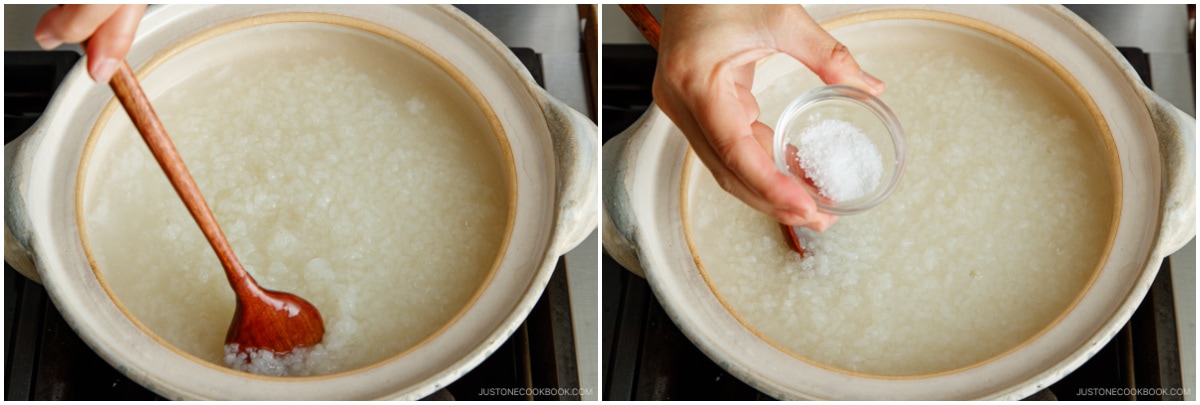
- Add the greens and daikon and stir to mix. Turn off the heat and cover tightly, then allow to rest and steam for 5 minutes.
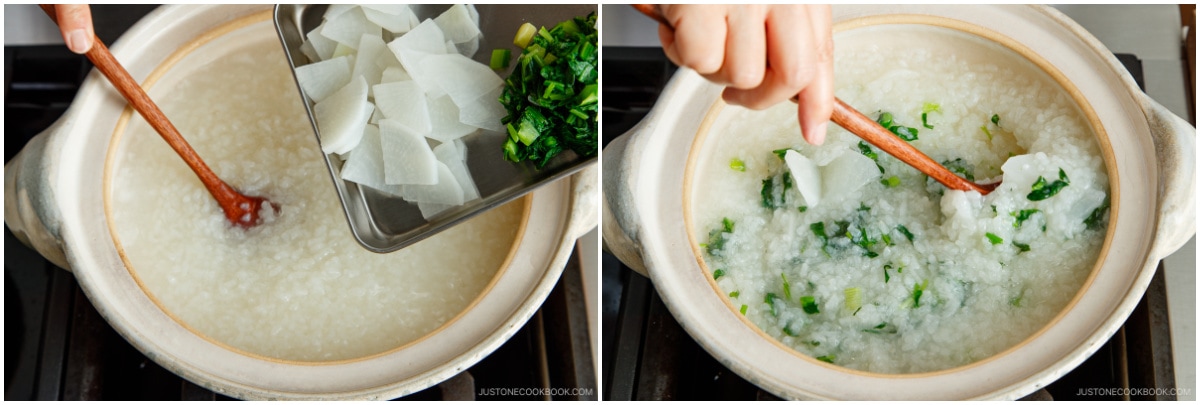
- Optional: If you are adding mochi to the rice porridge, cut 2 pieces Japanese rice cake (kiri mochi) in half and toast them in a frying pan or toaster oven until golden and puffed up. Add to the rice porridge.
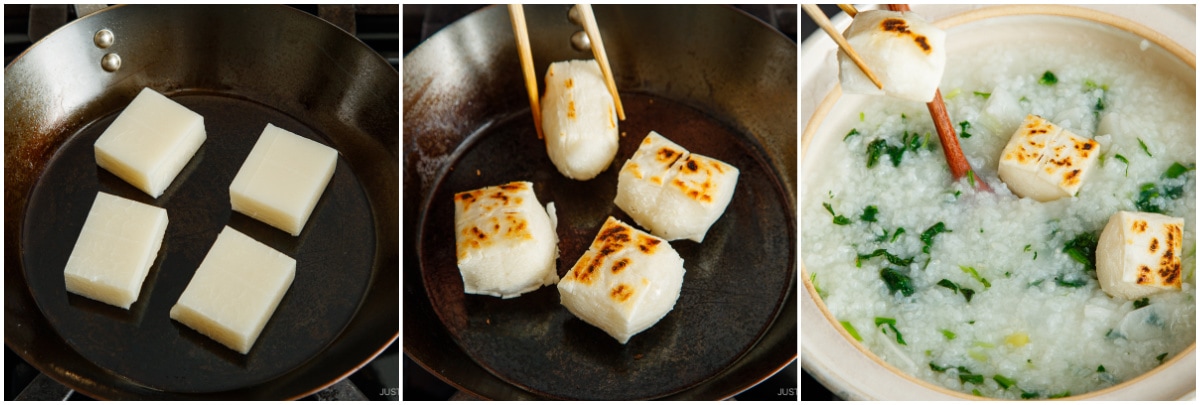
To Serve
- Serve immediately in individual rice bowls with salty condiments of your choice such as tsukemono, simmered kombu (tsukudani), or umeboshi.

To Make the Porridge with Cooked Rice (optional; 2 servings)
- One rice bowl of cooked rice yields 2 servings of rice porridge. In a donabe or heavy-bottomed pot like a Dutch oven, add 1 rice bowl cooked Japanese short-grain rice (1 cup, 150 g) and 2–3 rice bowls water (2–3 cups, 400–600 ml). Here, I used 3 rice bowls of water for 1 rice bowl of cooked rice to show a looser porridge consistency.
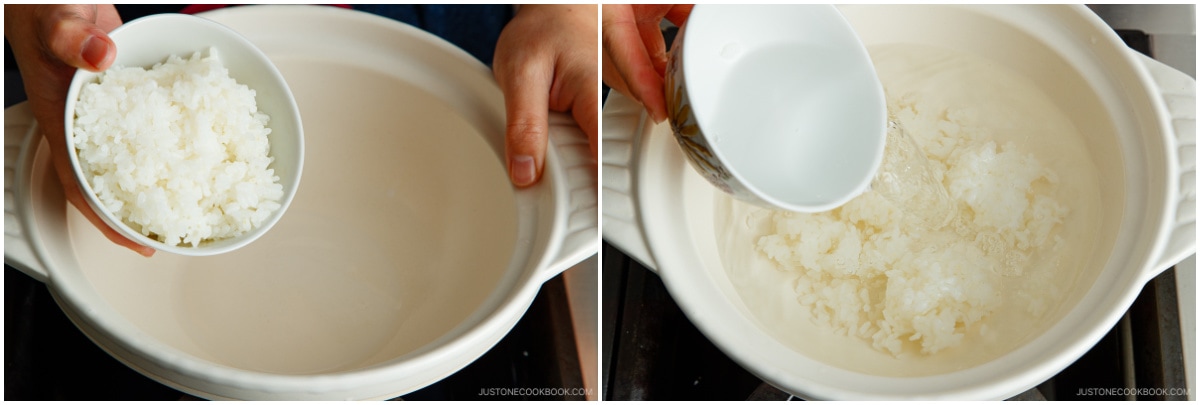
- Bring it to a boil on medium heat. Once boiling, stir the rice once and reduce the heat to low. Cover the donabe with a lid slightly ajar and cook for 10 minutes. Do not open the lid or stir while cooking.
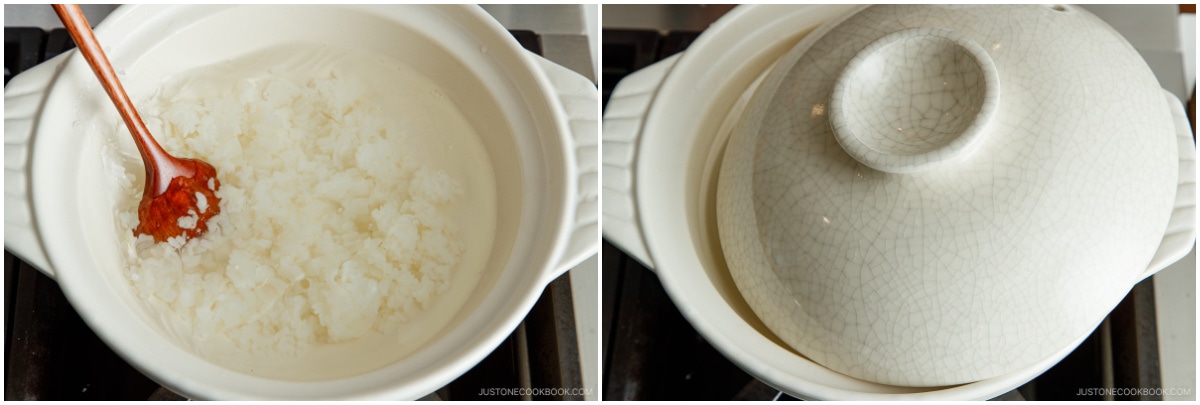
- After 10 minutes, check the consistency. Add the blanched greens and cooked daikon (see my previous steps on how to prepare them) and mix gently. For 2 servings, I used a half package (1 small packet) of freeze-dried nanakusa; alternatively, you could use 2 Tbsp cooked and chopped herbs/greens.
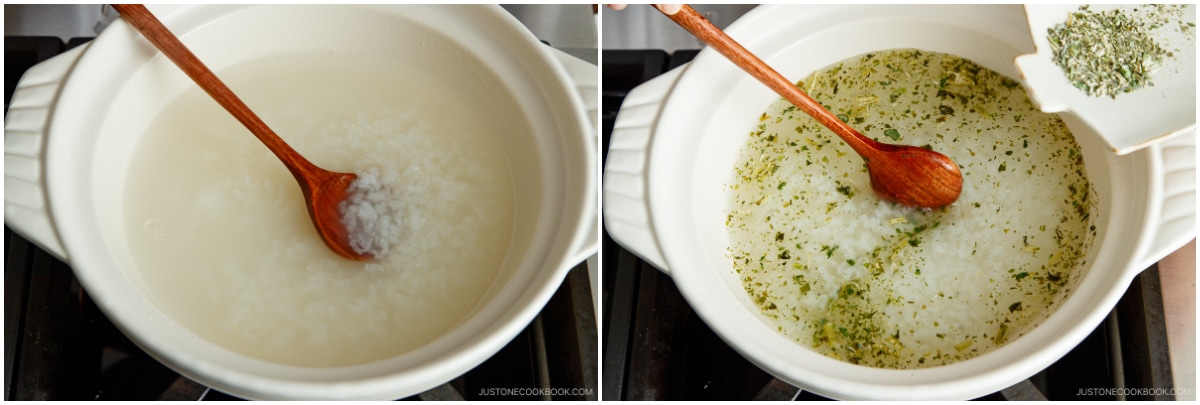
- Cook until the greens are warm and add ¼ tsp Diamond Crystal kosher salt to taste. Once the porridge reaches the consistency you like, serve it in individual rice bowls. Enjoy!
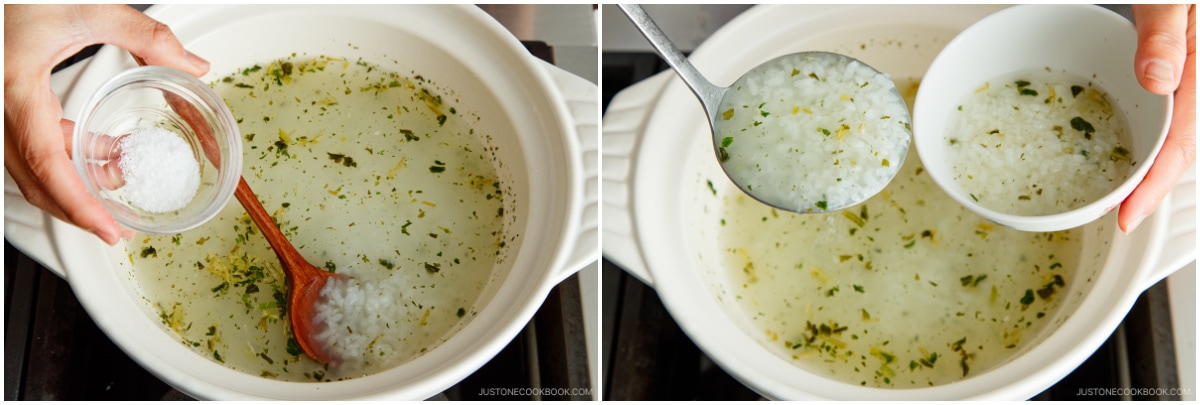
To Store
- You can keep the leftovers in an airtight container and keep them for 2 days in the refrigerator or for up to a month in the freezer.
Nutrition
Editor’s Note: The post was originally published on January 5, 2017. It was updated with new images, a revised recipe, and more helpful content on February 19, 2024.
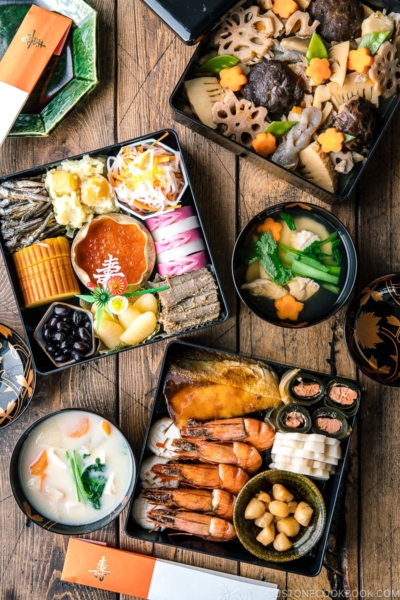
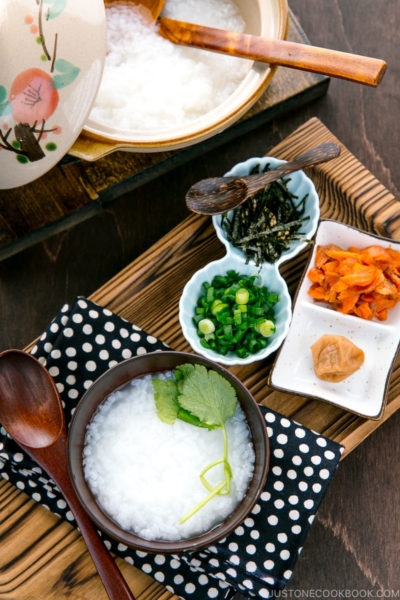
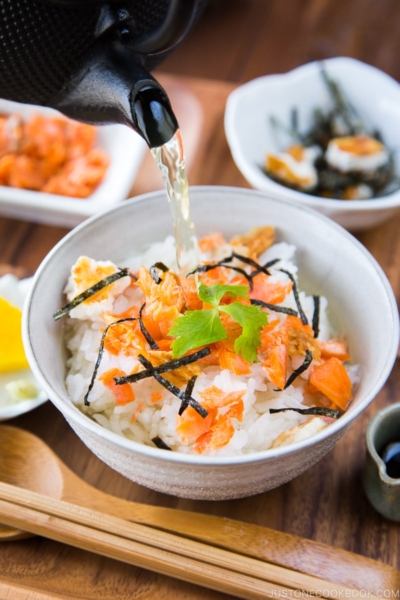
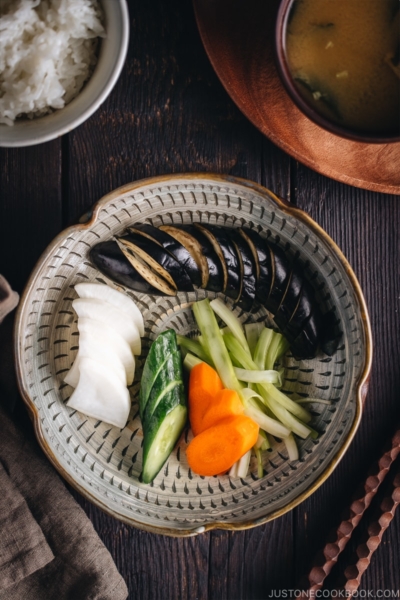




All your recipes looks delicious thanks for sharing Happy New Yearr to you and your staff
Hi June!
Happy New Year!🎍 Thank you very much for your kind feedback!
Hi, I have a question? Since it is hard to find these herbs fresh. Can I use packet and lose teas for the herbs that I can’t find. A few of these herbs as easy to find dried and in tea form at the local apothecary locations I frequent.
Hi Cori,
In Japan, a freeze-dried product is available. But we’ve never tried this recipe with loose teas, so it’s hard to say… maybe try it with a small portion first to see if it works?
Hi! I find it very sad, and kind of crazy (!) that nowhere do you mention that these herbs were first and formost simply picked in the wild… Seems like a pretty big thing to leave out in the “where to get these” part. Would be great if you could add it!
Most people have these, or similar, growing for free in their back yard or on the pavements of their streets… (in Europe, nipplewort is everywhere, the others I don’t know, but there are litteraly hundreds of equally free, nutritious and delicious replacements you can use!)
Hi Juliette! How nice that you live in a place where you can pick these in the wild (!!!!). Even in Japan, most people won’t have access to them so we buy these in a package that I showed in the blog post. I’ve also looked up here in the US (and some American readers did too) but these are not easy to find… Well, I live in California where everything is dry, so maybe that might be why…
どうもありがとうfor sharing the information about Nijiya carrying the 七草粥package! I’ve been thinking about making the traditional one this year and just found your page. I’m going to stop by Nijiya today!
こんにちは Miyuki-san! Hope you find it and enjoy the porridge. 🙂
Hi Nami,
I really love your posts. I’m trying to get healthy in 2020 and your recipes are helping me. Just as important my Son and Nephew are both very into all things Japanese. My nephew visited Tokyo a few years ago and absolutely loved it…everything from the people to the deer in the park / street to the history, bath-houses and food he would never even look at here in the U. S. And lets face it the Anime women help. All because of video games, the design and developement. They are both planning a trip together after my sons college is done.
So my reason for writing…do you know where you got your earthenware pot and those adorable little chop-stick rests? We have an H-Mart locally that is our oriental shopping mart so I’m interested to see if they have them, and the nanakusa kits or freeze dried herbs.
Lastly I’m just curious as to why you don’t speak the steps as you do them on your videos? Sorta like on food network? Or do you and I just don’t have the volume turned up. (LoL)
Thank you. I look forward to seeing you next week.
Melissa
Hi Melissa! Thank you so much for your kind words! It’s interesting that the younger generation starts their interest in Japan through anime and games and they are familiar with Japanese food and culture through what they read or learn from manga and games. Very fascinating!
This particular earthenware pot (pot for 1 person) is from the Japanese grocery store, but you can find similar ones from Asian grocery stores (They are mass-produced type and made in China). I think H-mart may carry it. If not, Amazon is another option.
If you are interested in getting more proper, higher-end product, then I recommend Toiro (https://toirokitchen.com/collections/all). I bought 2 Donabe and 2 Kamadosan (rice cooker donabe) and they are excellent quality made in Japan. This is supposed to last for a long time, so I think it’s a good investment.
I don’t like appearing myself in front of camera and I also don’t like my own voice (it’s not the most soothing sound people would enjoy). So we decided on the cinematographic style of video instead of cooking channels on TV, etc. Everyone has a favorite style, but we really enjoy focusing on food and technique, not much chatting. So far, people gave me feedback that they actually enjoy this type rather than people talking a lot (especially I don’t have that fun and entertaining personality to go with). My recipes have step by step images and print function, so I don’t really need to give instructions on cooking (which makes the videos even longer and not everyone has time to watch). So videos are made just to give an idea of how the cooking is done. Detailed tips and instructions are always provided on the blog and recipe. I hope this makes sense. 🙂
Thank you again for your kind feedback! xo
Thank you for this wonderful recipe. What brand(s) of Japanese rice do you recommend. I live near a huge multi-national grocer (Lee Lee) in Arizona.
Would also appreciate more Instant Pot and vegetarian recipes.
Happy New Year!
Hi Janis! I buy either rice from Japan (Available ones are from Toyama prefecture or Hokkaido prefecture – You can get them in Japanese grocery stores called Nijiya in California). I’m not sure about the grocery store you mentioned (I don’t see it here in SF area), but Koshihikari or Tamanishiki are both pretty good.
https://www.justonecookbook.com/japanese-rice-everything-you-need-to-know/
Hi!
I am confused by the following instructions.
Rice-Water Ratio:
Zen-gayu – 1 : 5 (50 grams : 250 ml)
Shichibu-gayu – 1 : 7 (50 grams : 350 ml)
Gobu-gayu – 1 :10 (50 grams : 500 ml)
Sanbu-gayu – 1 : 20 (25 grams : 500 ml)
Are they different kinds of rice grains or are they different consistency of porridge?
Thanks. Faye
Hi Faye! It’s a different style of porridge based on water amount. Each style has a specific name for it. I did not want to go into too details but I wanted to give the ratio for those who already know the different styles and look for the water measurement.
I love reading your blog! I’m japanese American, so while we cook and eat plenty of Japanese foods, there are some things that got lost over the generations—nanakusa gayu being one. Is there a reason I shouldn’t use leftover rice to make this?
Hi SK! Thank you for reading my blog! You can use leftover rice too. 🙂
Hi Nami! I only have/use brown rice. Would the water to rice ratio be the same and would I just cook it longer????
Going to make this with your pork/lotus fried sandwiches on Monday 🙂
Brown rice needs to be soaked overnight or longer, and it needs to be cooked with more water for a longer time. I don’t usually do 100% brown rice (I do 1 brown: 2 white), but I will try to make the recipe for brown rice this year… Enjoy the pork/lotus root dish!
I tried making porridge but since I don’t have an easy access to an asian supermarket, I couldn’t get the herbs necessary. So I wondered what kind of more “accessible” herbs I could use other than the ones mentioned in your post, since I still don’t really know how to use them right now.
By the way, I really love your recipes and for a beginner like me (I’m 17 years old), they are very easy to make without mixing things up! Thanks a lot since I could finally make the recipes I found in anime or else.
Hi Rose! Thank you for asking! Some of JOC readers have tried this recipe with non-Japanese herbs. One of them is Lion who gave me a list! He used radish leaves, celery leaves, dandelion leaves, flat parsley, chives, mint, fennel. Hope this helps!
I’m so happy you started cooking Japanese food. Good luck and happy cooking! xo
I had not considered the turnips and radishes herbs but I guess that is a bit like the difference between a plant and a weed. One is an authorized planting and the other isn’t. The Gayu set looks like it includes the turnip but the freeze dried doesn’t look it does. Is the turnip and radishes grated into the porridge or are just the tops used?
Oops. Saw the fresh instructions a bit late.
Hi Sang! It looks like this custom has been around since 700. These plants/herbs are not common herbs we use in our daily cooking (except for daikon and kabu), and in Japan we say Spring Seven Weed/Plants (七草), but English translation is 7 herbs… 🙂
Hi Nami, I have never heard of Nanakusa, and was interested in trying it. .3Unfortunately, the Nijiya in Mtn View did not have it. The two people that helped me were not familiar with the freeze dried package.. I will try to remember this for next year though. Thank you for introducing this to us.
Hi Joanne! Every year when I called the supermarkets (including Nijiya), they don’t know what I’m talking about, so I have to ask to a Japanese person in Japanese and I can finally get answer (if they have Nanakusa). I assumed they carry same/similar stuff… San Mateo stores get a lot of stuff from Mountain View (all the meat and fish is packed there), so I’m surprised Mountain View location does not carry this same item… (and doubt they run out). 🙁 Sorry you couldn’t find it. Hopefully you can find it next year toward the end of the year. I found this package after the Christmas, along with New Year’s Day items. 🙂
I agree with your comments, Namiko. After the holidays I am so tired of all the rich foods. So, thank you for posting this recipe. My “ohara” tells me every year at this same time that it needs something to calm it down.
Have a wonderful time skiing our beautiful Utah terrain.
One of these times when you come it would be wonderful to meet you. I know there are many of us from the Salt Lake Betsuin who follow you and would love to have a “meet and greet?”
Omedetto gozaimasu……………..
Hi Lisa! Akemashite Omedeto! You live in Utah! So sorry I just saw your message (and I’m at the airport flying back). I was at Salt Lake Roasting Co in downtown to meet the owners who are JOC fans. Next time maybe all of us can meet together! 🙂
Thanks for sharing! I think I shop at the same Nijiya as you, so I’ll have to see if they still have the freeze dried version :). Do you remember if it was by the furikake? I’m definitely a little tired of all of the new year food, and I was thinking of making some zosui, but this sounds great too!
Hi Vicki! I go to one in San Mateo. It was at the front area and wasn’t in the isle. Since it’s almost the 7th, I think it’s still out in the front. 🙂
Hope you like it! Zosui sounds good too!
Can I make the seven herb rice recipe in my rice cooker?
Hi Barb! Does your rice cooker have porridge function? If it does, yes you can make it in the rice cooker. If not, you have to make rice first and then cook the cooked rice and some water in a pot (if you want to use cooked rice). 🙂